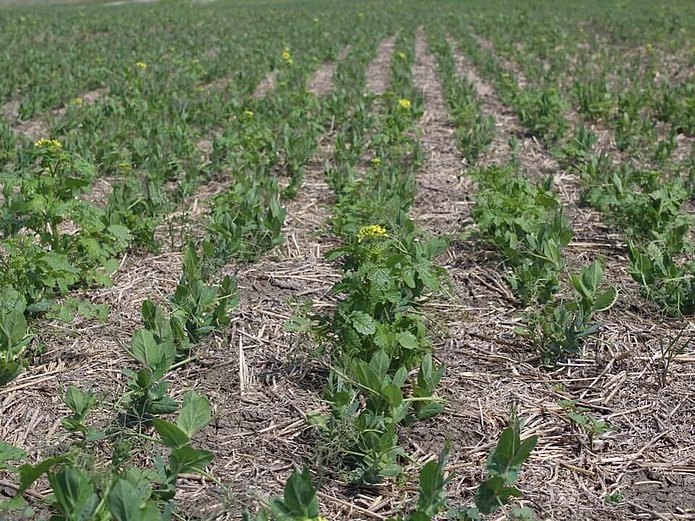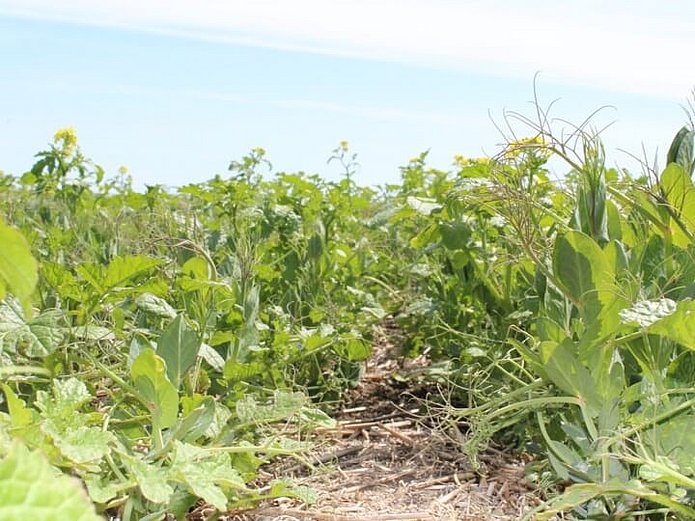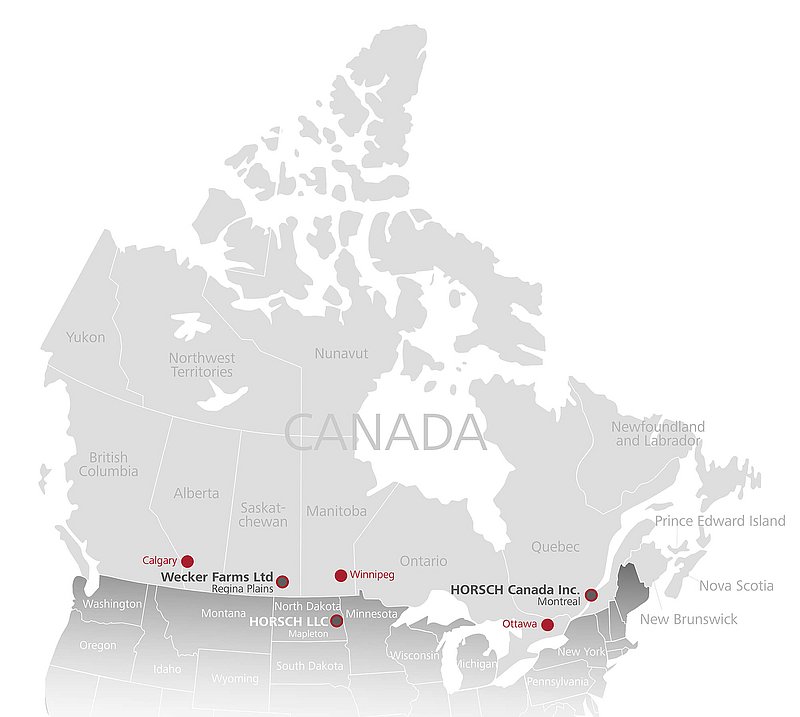
Healthy soil – healthy plants
Joe Wecker runs a 9,000-acres farm in Canada. He does not only work according to the principles of organic farming, but also uses companion crops and inter-crops and improves soil health by applying plant auxiliaries. He talked to terraHORSCH about his experiences.
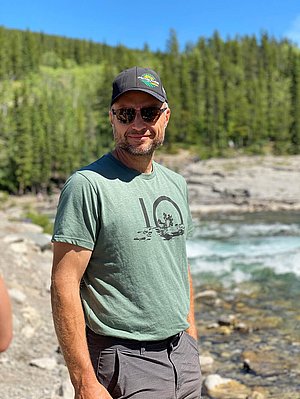
Companion crops and inter-crops, auxiliaries, soil health and a varied rotation – these were the topics Joel Williams, an independent plant and soil health educator, wrote about in the last two issues of terraHORSCH. Joe Wecker, a farmer with German roots from Regina Plains in the south-east of the province Saskatchewan, Canada, uses these principles in practice. The family farm which he runs together with his father and two permanent employees is situated between Winnipeg and Calgary just over 100 km north of the US American border. The region is extremely flat, there are no windbreaks. The average annual rainfall amounts to 380 mm, though in the past four years there was significantly less rain – a total of 50 mm per year. However, this season it finally rained some more. Winters in Regina Plains are very cold, the summers are warm.
Wecker Farms are located on a main road. On the one side there are two residential buildings as well as the farm buildings including an impressive silo installation with drying and cleaning. More about why the latter is important later. Only some metres away on the other side of the road are further silos. The farm and the inventory are very well kept. Tractors and combines mainly are from John Deere. The farm uses a 9560 RT, a 8370 RT, a 6215 R as well as a Fendt 1050 Vario, two combines with 14m cutter bar and two swathers with 12 m working width. They sow with an 18m machine with liquid fertiliser system. Moreover, they use a fine cultivator for tillage in spring, harrows and hoes as well as a roller-type harrow. The harvest is transported from the combine with an auger wagon and from the field boundaries with three trailer trucks.
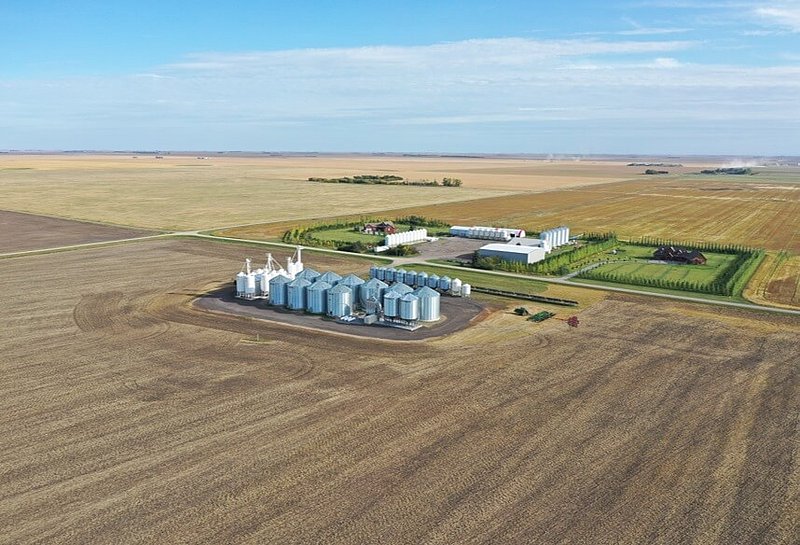
They farm more than 3,500 ha, 2,500 organically, the remainder is in transition to organic farming. “But everything is farmed in a nutritional farming system“, Joe Wecker says. This is why the farmer considers his machine park to be rather large. In his opinion, nutritional farming on the one hand means diversity of crops, cover crops, inter-crops and green manure. Moreover, he relies on the specific use of plant auxiliaries. He grows: durum, HRS wheat, oats, flax, alfalfa seed, khorasan wheat, spelt, emmer, peas, lentils and chickpeas.
He flexibly uses different companion crops depending on the rotation. For example: cereals/cereals-clover, cereals-alfalfa, chickpeas-flax, pea-mustard, pea-oats or barley, lentil-oats, lentil-brassica as well as brassica-pea-clover.
Less risk
But why does he do this? „Intercropping, i.e. the cultivation of companion crops and inter-crops, means more bio diversity“, the farmer is convinced. “The result are very positive consequences for soil fertility, for beneficial insects, for the encouragement of mykorrhiza and for nutrient exchange – this is particularly apparent for peas as a companion crop, as well as for a synergistic growth. There is no competition, less fertility inputs are needed. There are higher residues for ground cover, less weeds and harvest residues decompose faster. And: risk reduction, especially in very dry years.
My experiences for example with oats in combination with peas were very good. Their root structure and its function, too, are completely different. There are different pH values in the different areas and nutrients, too, are released differently. If you dig up the plants, you can perfectly see the rhizobia that fix the nitrogen. Another example is the combination of brassica and maple peas. We grow them together because the peas often get lodged before the harvest. But the brassica supports them so there are hardly any problems when threshing. It works excellently. For maple peas really are rather difficult to grow. Thus, we get a high price for them, and brassica is a great help“, the farmer explains.
For organic flax with chickpeas. “We cultivated these crops two years in a row”, Joe Wecker says. “Normally chickpeas have to be treated with fungicides five to six times. But being a certified organic farm that’s no option for us. With the combination we had the experience that we don’t need any fungicides at all. There are some processes, probably in the soil, which make them unnecessary. You can clearly see it.
Another combination we like to use is organic Eurasian wheat with clover as an under sown crop. I attach major importance to one thing: For me, intercropping does not only mean to grow mixed crops where both partners are used. In my opinion, it also includes companion crops where only one crop from the combination is harvested. I like to use this for cereals, for example for oats and peas. This actually is one of my most favourite combinations. It is always striking how healthy the leaves are. Another example is oats with marrowfat peas. The latter poses quite some challenges for the farmer. In combination with oats it is much easier. Especially the weed pressure is lower.“
Positive effects
Joe Wecker describes another possibility: HRS with alfalfa as an under sown crop. Especially when producing alfalfa seed there again and again are volunteer plants in the following years. Although, in this case, he specifically uses them as a companion crop, he has to see to it that the alfalfa share does not get too high. The cereals then have a better chance to pass the alfalfa. The positive effect Joe Wecker noticed are 1.5 to 2 % more protein in the wheat. And all that without any yield losses. Using an underseed with alfalfa, thus, is ideal if you want to achieve an increased protein content for wheat. According to his expercience, brassica with maple peas also work very well together. Threshing can be carried out without any problems by simply changing a few settings at the machine.
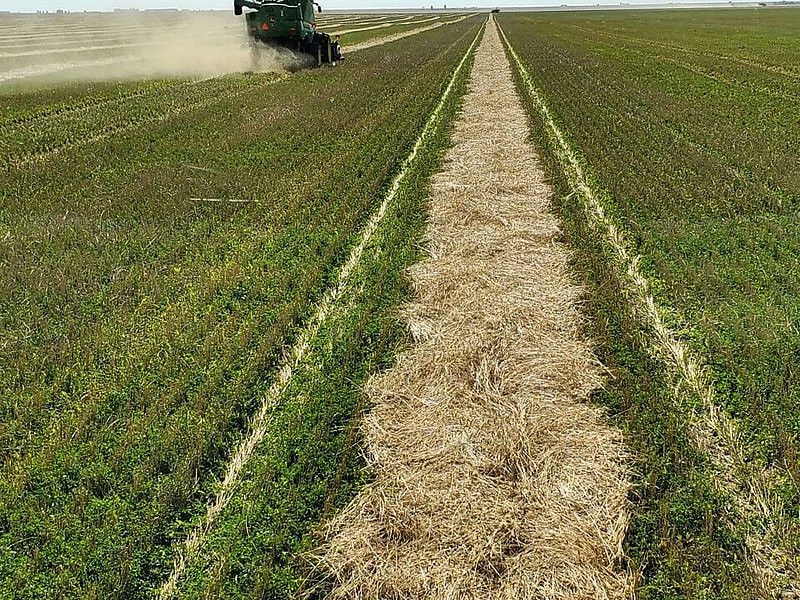
According to Joe Wecker you immediately see the effects of intercropping. Right in the first year he did no longer have to use any fungicides for the combinations flax-chickpeas and flax lentils. With regard to soil health, it takes a little longer. Over a period of three years, step by step we reduced the fertilising intensity and now the quantiy is only half as high compared to the time he started. During this time the biological activity of the soil improved – with stable yields. The plants in total, benefit from not being filled up with nitrogen to such an extent. The pressure of fungi and animal pests decreases significantly.
Joe Wecker attaches great importance to soil and nutrient analysis. “I focus on the correlation of what is in the soil and what is in the plant”, he says. “Or rather: What is in the soil and what is not in the plant. For you cannot take it for granted that everything from the soil is available to the plant. You need an intact biological activity of the soil. This is why we do not only carry out soil analysis, but also tissue test of the plants. If we notice any peculiarities, we know that we have to do something for a good biological activity of the soil. In addition to our inter-crops and companion crops which also have a positive effect on it.
No matter if organic or conventional – we apply stimulants on all our fields to encourage the activity of the soil especially in the root area. It thus gets a boost so that the plant can dispose of some nutrients that so far have not been available.”
Regular analysis
At Wecker Farms, the tissue tests are carried out at least once a year. Joe Wecker compares them to the soil analysis and if he notices that nutrients are not available to the plant he spreads them.
It usually is boron that is applied together with kelp and fulvic acid. It is not expensive. And it does not do any damage, Joe Wecker says. But he achieves this little boost for the soil activity.
But back to the soil and plant analysis. Joe Wecker describes the results of an analysis of the fields that are still farmed conventionally. “The crop is flax. I did not apply any phosphor. The analysis showed only half as much nitrogen as there actually should be. But I did not worry about that at all. And the population really develops excellently. Before our objective always was how to achieve the highest possible yield with a high effort. Today we do the opposite: we focus on how little effort is necessary to not lose yields.
During the vegetation period we always have the refractometer at hand. We, thus, can find out very quickly on site how healthy the plants are. By means of the sugar content we notice if there are any shortcomings. If so, we immediately carry out a laboratory test to get exact data. If for example we apply boron, we mix in fulvic acid, kelp and a little bit of sugar. Sugar is good for beneficial organisms.“
You cannot take it for granted that everything from the soil is available to the plant. You need an intact biological activity of the soil.
Consequent action
The conversion of the farm to organic farming started five years ago. Asked about his reasons the farmer answers: “On the one hand, we ourselves have been eating organic food for quite some time. On the other hand, we noticed soil degradations on the farm. This is why we started to think about intercropping. We also questioned a lot and tried to detect correlations. You often do not notice small things until the problems get bigger. And then you start to think.
With regard to the yields, the losses are really minimal compared to my neighbours. However, it depends on the crop. For barley and flax for example it is hardly noticeable, for wheat we talk about 10 to 15 %. In this case it is very important which variety you chose: Modern wheat only achieves good yields if the nutrient supply is optimum. Therefore, we prefer older varieties which usually are still on the market. If not there often are some remaining stocks. Barley in turn is less sensitive according to our experience.
But yields are not everything. I often discuss with the mills I supply directly. This is the reason why the cereals are thoroughly cleaned and dried. My customers often tell me: We love your cereals. Our bread tastes a lot better with it. As I already said before: In the future, our customers will no longer only pay for the quantity, but also for other things. For example also for chickpeas what are produced completely without using fungicides.
I wanted to farm in a regenerative-organic way for quite some time. My focus has always been on soil health and especially on what we can do to improve it. This is behind everything we do. For a healthy soil guarantees healthy plants. The same is true for insects. We attach major importance to that the fact that our fields provide a good living environment for bees and other beneficial organisms. In this respect, intercropping is ideal, for we automatically create areas where insects can thrive in an optimum way.
And last but not least, I am convinced that our customers expect more from us than just always going on like before. This will not only be an important reason for them to co-operate with us. They will also reward it.“
